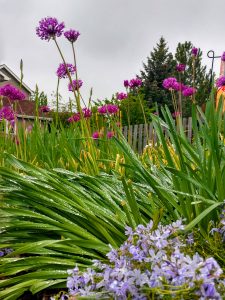We’ve had some on-again-off-again kind of weather this spring: sunny and warm for a few days, followed by several days of clouds and rain. If rainy weather makes you feel dreary, the plants around you are feeling lethargic, too.

Perhaps you recall from your high school science class that plants require sunlight as part of their photosynthesis process. Without sunlight, the plants are unable to convert nutrients and carbon-dioxide to energy through the photosynthesis process. On cloudy days, they produce much less of the energy they need to grow and bloom.
Additionally, the plants’ circulatory system slows down in cool weather. Plants don’t have a heart (obviously) nor any type of pump for their circulatory system. Rather, water carries nutrients up through the plant from the roots to the shoots using physics: capillary action, osmotic pressure in the cells, and hydraulic conductivity. This process is called transpiration and when the weather is cool and humidity is high, transpiration rates are low. Thus, on rainy days, plants are both unable to produce new energy and unable to move nutrients to their cells so their growth rates slow down significantly.
You many notice some of the plants in the landscape are sort of stuck. For example, my Peonies are covered with buds, but they’re just not opening. Also, I’m finding that many of the annual plants I like to put in container gardens are smaller than they’ve been in previous years. Many of them have buds, but just aren’t blooming yet – they need a few good days of sunshine to open their flowers completely. While the nurseries are able to control much of the climate for nurturing plants, they are not able to replicate sunlight on a large scale. I don’t control the weather either (even though I might wish to). Rather, I just trust that warm, sunny days are coming soon and the plants I know and love will bloom reliably as soon as the weather cooperates!

